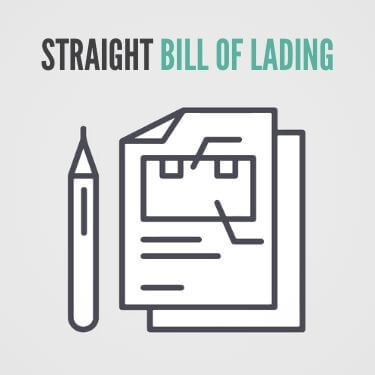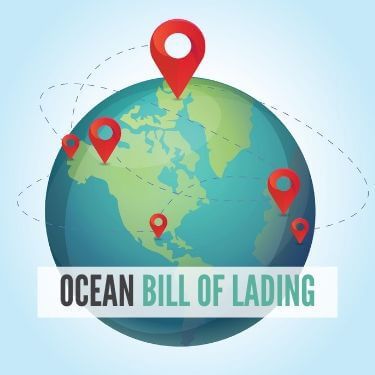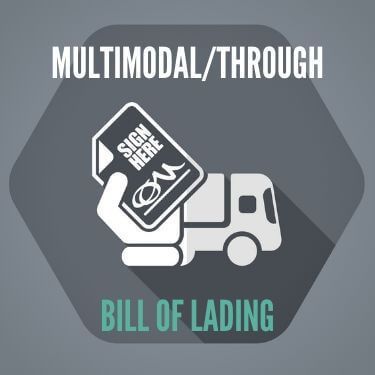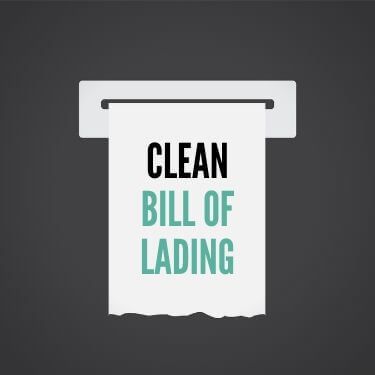A bill of lading or BoL refers to a legal document that a carrier issues to a shipper, which details the goods that are being carried. This includes information on the type and quantity of the goods and where they are being shipped to. However, different types of bill of lading are used in certain situations. Knowing the details of each type is important for all parties involved.
8 common types of bill of lading are:
Each of the types of Bill of Lading have important differences that businesses shipping freight need to be aware of.
The article below will provide you an in-depth look at each type of bill of lading. In each section, we’ll take a look at when each type is used and the vital information that should be noted.
Before diving into each type of bill of lading, it helps to understand what the overall purpose of a BOL is.
A bill of lading, which is commonly referred to as a BoL or B/L, serves three different roles. These are as follows:
The first example that we are going to take a look at is a straight bill of lading. This is also sometimes referred to as the consignment bill of lading. This relates to a bill of lading that is not negotiable. It is utilized where the products have already been paid for or payment is not needed. Under this form of a bill of lading, the company that is shipping the products will deliver the shipment to its consignee once identification has been presented.
With this type of bill of lading, it states that the items are consigned to a person that has been specified and this is not negotiable. A straight bill of lading is a document whereby the seller agrees that a certain transportation will be utilized to ship the goods to a specified location, and then a specific party is going to be assigned the bill. Everything is outlined and straightforward, and these factors cannot be changed. A straight bill of lading will also provide information regarding the product or products, including the type, quantity, and quality. Moreover, when the items have been delivered to the destination, the bill of lading also acts as a receipt. Due to the fact that the bill of lading is assigned to a specific person or party, it cannot be reassigned to another party and it is simply not negotiable.

A short form bill of lading is one whereby the carriage’s terms and conditions are not printed on the back. This is also sometimes referred to as a blank back bill of lading. These bills of lading are not seen very regularly. This is because people feel greater comfort and peace of mind when it comes to the longer version, which features the terms and conditions printed on it.
There are a number of other types of bills of lading that are not used on a regular basis, so let’s take a quick look at these:
There are many potentially confusing terms and acronyms in the world of freight shipping. To learn about many more of them, read our article Freight Terms You Need to Know
Next, we are going to take a look at an ocean bill of lading, and the name may give you a bit of indication regarding what this refers to. This is a document that is needed when goods are being transported to another country via international waters. An ocean bill of lading is going to serve as a collection invoice or document as well as being the receipt from the carrier to the shipper.
With an ocean bill of lading, the shipper will be able to transport their products across international waters. This contract or document supplies the specifics in terms of the nature of the shipment, as well as details on where the goods are going to be shipped to, what material is being transported, and how much of it is being transported. There are other pieces of information that will be incorporated into the contract as well, for example, the sort of packaging being used during the transport and the value of the products being shipped.

When the goods are collected, the shipper will get their contract. The carrier and the shipper will both need to sign this document. Once the shipment is completed, the receiver will be given the document and they must also sign this.
If the goods need to be transported via land first, then there is going to be an additional document that is needed. This is known as the inland bill of lading. This bill of lading enables the materials to reach the shore. The ocean bill of lading will then enable the products to be shipped to another country via the water.
A good example of cases whereby an ocean bill of lading is required is when a car manufacturer ships their vehicles overseas to different dealerships around the world. When this happens, an ocean bill of lading must be filled out and completed for the goods to be transferred. If the vehicles are then going to need to be transferred further into the country of where they have been shipped to, an inland bill of lading is then needed to move the vehicles. After all, it is unlikely that the vehicles are simply going to be transported to the port - they are going to need to go further inland. So, for example, a dealership based in the United States will sign an ocean bill of lading with a Chinese carmaker for vehicles to be transported into the United States. Let’s say the shipment arrives in Seattle, however, it needs to go onto New York. An inland bill of lading is then going to be required for this second part of the transportation process.
There are a number of different ocean bills of lading that can be utilized. We previously explained the straight bill of lading, which can be used. Once the receiver shows identification, they will be able to take the shipment. On the flip side, a negotiable bill of lading is typically put into place when the shipper wants to make certain that specific terms and conditions are adhered to prior to the release of the shipment to the receiver. This is also used when the payment from the receiver is backed by a letter of credit.
Next, we have an order bill of lading, which relates to a bill of lading that is negotiable. It is made out to a certain person and it can be transferred by delivery and endorsement of the bill. This means that the ownership of the products under the Bill of Lading/Airway bill can be transferred to another party. This is the opposite of a straight bill of lading.
Order bills of lading have two functions in global trade transactions. They stop the cargo being delivered to unwanted parties. They also enable the consignee to transfer the title of goods to another party with endorsement and delivery of the original bill of lading.
Should you be dealing with payments via letter of credit, either as a bank professional, importer, or an exporter, you may recognize that the bank in question demands the bill of lading to be made out to their orders.
Issuing banks want shipments to be secured, which means that they will take all of the actions needed to stop the consignment being delivered to the applicant without their acknowledgement. For this result to be achieved, issuing banks request bills of lading that are negotiable. This should be issued to order of the issuing banks, from the exporters under the letter of credit transactions.
After a bill of lading has been made out to order of the issuing bank, it means it can be issue in negotiable form, fulfilling two main functions. The first means that consignment cannot be delivered to the applicant, which tends to be the importer business, as the carrier can only release the goods to the person that is the lawful holder of the original negotiable bill of lading. The issuing bank will also only endorse and deliver the bill of lading once the bank receives the letter of credit amount from the importer.
In addition to multiple types of bill of lading, FOB shipping terms can also be confusing. To learn about FOB shipping terms, read our article What Does FOB Mean in Shipping?
Multimodal and through bill of lading are very similar, which is why we have grouped them together. However, it is important to understand that they are not identical. The main difference between a through bill of lading and a multimodal bill of lading is that a through bill of lading only involves one mode of cargo movement yet there are different legs, like inland waterways and the sea. On the flip side, there needs to be at least two modes of cargo movement in order to require a multimodal bill of lading, for instance, land and sea.
Multimodal transportation refers to several methods of transport being used to move one unit load to its destination without the unit load being broken up and under one document. A lot of people refer to a multimodal bill of lading as a bill of lading for combined transport. One of the best examples of this relates to packages that travel via train to a port, then via vessel over water, and then via truck to the final destination.

As mentioned earlier, there are through bill of lading and multimodal transport bill of lading. In regards to multimodal, the multimodal transport operator will issue these, and they tend to be printed on the standard pre-printed form from the International Federation of Freight Forwarders Associations.
The Multimodal Transport Operator (MTO) will issue a Multimodal Transport Bill of Lading. The MTO will take responsibility for the products during this entire period of transport, i.e. for damages, losses, and shortages. This means not only for sea passage but for other transport modes too.
With a Through Bill of Lading, the carrier would issue this. However, on the contract, the carrier would have stated that they are only responsible for the items when they are in the part of the carriage they take care of, for example, while at sea.
A Bill of Lading can be issued as either a Master Bill of Lading (MBL) or a House Bill of Lading (HBL). A Master Bill of Lading is issued to the Freight Forwarder or NVOCC Operator from the Shipping Carrier. The House Bill of Lading will be issued by a Freight Forwarder or NVOCC Operator to their customers.
In an MBL, the Shipper will typically be the Freight Forwarder, the NVOCC operator or their agent. The Consignee will typically be the office of the NVOCC operator, Freight Forwarder, the destination agent, or counterpart.
Next, we have a clean bill of lading. The clean bill of lading is a form of an ocean bill of lading that is a contract between a carrier, shipper, and the receiver of products shipped overseas by water. This is a document that will declare there was no loss of goods during shipment or no damage to goods. The product carrier will issue the clean bill of lading after the packages have been thoroughly inspected for any deviations in quality, missing quantities, or damage.
What about a dirty bill of lading? A dirty bill of lading can also be called a claused bill of lading or a foul bill of lading. This indicates that there has been some form or loss or damage to the goods during transport. As mentioned, a bill of lading acts as a receipt upon arrival at the destination as well as being the document whereby parties agree on shipping a good. Therefore, a dirty bill of lading acts as a receipt confirming that the items have arrived in a way that they should not have been. Most banks and other institutions that finance the shipment will not accept or honor claused bills of lading. This means that the seller will tend to have trouble getting payment on them.

Next, we have a release bill of lading, also referred to as an express bill of lading. This is a bill of lading where the carrier has an obligation to provide the products to the consignee who has been named and there are not any original bills of lading (OBL) issued. This is a non-negotiable form of a bill of lading, not a document of title to the goods. Release bill of ladings are regularly used when the importer has credit with the supplier or has paid for the products prior to shipping.
If you need help shipping freight, you have certainly come to the right place. At R+L Global Logistics, we have many years of experience in the industry and we can ensure your freight reaches its destination without issue. Regardless of the type of bill of lading your shipment requires, you can rest assured that your freight will be delivered on-time. Whether you're looking for a refrigerated freight quote, an expedited freight service, or full truckload shipping we're ready to serve you.
We use our vast logistics network and knowledge to provide you with the best service available. To get started, give us a call at (866) 353-7178 or click Freight Quote below to speak to one of our logistics and transportation experts. If you have any questions, we are more than happy to assist you in any manner we can.
R+L Global Logistics
315 NE 14th St., Ocala, FL 34470